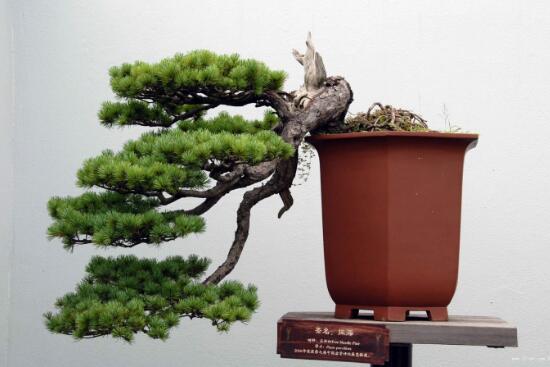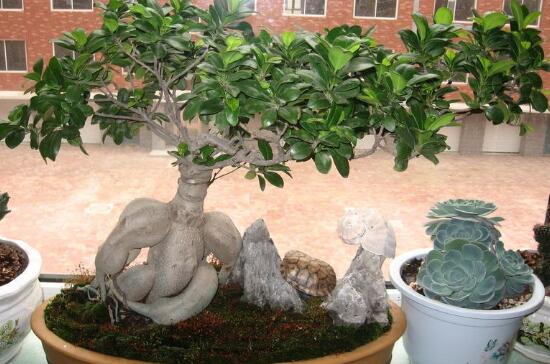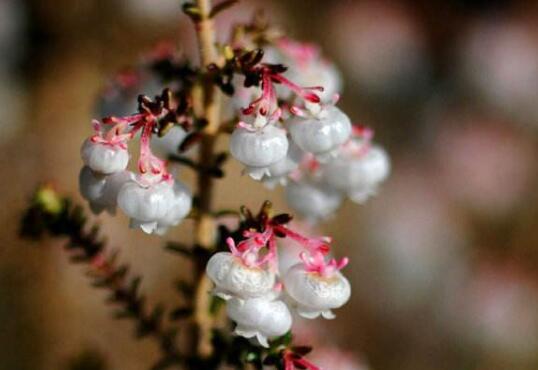How to water and fertilize bonsai: how to fertilize banyan bonsai and how often banyan trees are fertilized
"A flower in a crop is dominated by fertilizer." although the banyan tree is not beautiful to blossom, it grows rapidly and needs sufficient nutrients. However, fertilization, like watering, is a technical activity, and the choice of fertilizer, the number and amount of fertilization should be well controlled. So, how to fertilize the banyan bonsai? How often does the banyan tree fertilize? Today, the editor is here to solve this problem for everyone.
First, how to fertilize banyan bonsai, time / fertilizer species / skills

The banyan tree likes fertilizer and needs sufficient nutrients in the growth process, but excessive or concentrated fertilization will cause damage to the growth of the plant, and there will be symptoms such as yellowing and blackening of banyan leaves. Therefore, how to apply fertilizer to banyan bonsai requires us to strictly grasp the time, fertilizer species and fertilization skills, and the amount of fertilizer should be different according to different seasons.
2. How often should banyan trees be fertilized, once a month
1. Banyan trees that have just been bought or have just changed their pots should not be fertilized. At this time, the plants are still in the adaptive stage and should not absorb fertilizer. Every 2 years, banyan trees should be changed in spring. However, after changing the basin, you must wait for the temperature to rise above 20 ℃ before fertilizing.
2. In the three seasons of spring, summer and autumn, banyan trees are in a period of rapid growth. In order to meet the growth of banyan trees, flower friends should apply rotten fertilizer and water once a month, with little or no fertilization in winter.
What is the fertilizer for bonsai banyan trees
In the process of cultivating banyan trees, many flower friends want to know what kind of fertilizer banyan trees use. In this regard, the editor suggests that everyone should use fertilizers, mainly nitrogen, phosphorus and potassium, and apply them once a month during the growing period, 3-4 times a year. It should be noted that the proportion of nitrogen, phosphorus and potassium fertilizer should be applicable, otherwise it will cause the leaves of banyan trees to turn yellow.
4. Tips on fertilization of banyan trees
When applying fertilizer to the banyan tree, just bury the fertilizer in the soil, do not come into direct contact with the root, avoid fertilizer burning the root; when fertilizing, you can turn the fertilizer into fertilizer and water, and then irrigate along the basin wall. Pay attention to the fertilizer can not be spilled on the leaves, and the fertilizer can not be too thick, otherwise it will cause banyan trees to grow.
Fifth, how to apply too much fertilizer to the banyan tree and dilute it with irrigation
For beginners, when fertilizing banyan trees, there is often too much fertilizer, so what should we do at this time? At this time, everyone should water the banyan tree thoroughly and let the water take the fertilizer out. At the same time, move the plant to a ventilated shade and let it recover slowly. Do not start fertilizing until the temperature is above 20 ℃.
On the banyan fertilization method, the editor introduced here, after reading, we should have more confidence in raising banyan tree! Generally speaking, the banyan breeding method is not difficult, difficult in some details, whether it is watering, or fertilization, must be appropriate, neither more nor less. Only in this way can you raise a beautiful banyan tree!
How to raise banyan bonsai and how to cultivate banyan bonsai
Banyan bonsai has a unique shape and has high ornamental value. Among the bonsai plants at home, the banyan bonsai is more popular because of its evergreen seasons. Is the banyan bonsai easy to raise? The author raised such doubts in the bonsai culture of banyan trees for the first time, fearing that the survival rate of culture was not high. After all, it's all a painstaking effort. Fortunately, I referred to many methods and precautions of cultivating banyan bonsai at that time, and successfully cultivated the first banyan bonsai of my own life. Generally speaking, breeding banyan bonsai is a simple thing, as long as it is cultivated according to the growth habits of banyan bonsai, the survival rate is very high!
Methods of banyan bonsai culture 1. Soil selection of banyan culture
Banyan trees like a sunny, well-ventilated, warm and humid environment. When the summer weather is hot, it should be properly shaded, and often sprinkle water to the ground to maintain a certain degree of humidity in the microclimate. In the north, in late autumn or early winter, banyan bonsai should be moved indoors to survive the winter.
two。 Fertilization methods for banyan culture
In the growing season, the rotten and thin organic liquid fertilizer is applied once a month, and the "alum fertilizer water" is applied in May and August every year. Don't apply too much fertilizer to banyan trees. Fat branches grow, but the leaves are not beautiful when they are bigger. Do not apply fertilizer in hot summer and winter.
Because the banyan tree grows fast, it can be fertilized outside the root once a day after normal growth, using mature human and animal urine or compost as topdressing, and bottom fertilizer can also be applied when changing pots. Sufficient fertilizer can make the trunk grow strong. If the potted soil is fertile, there is no need to top up fertilizer, but foliar spraying can be carried out with nutrient solution in the growing period of summer and autumn to make its branches and leaves dense and green, giving people a sense of beauty.
3. Watering method of banyan tree culture
The banyan tree is a tropical plant, like big water and big fertilizer, its adaptability is very strong, can grow in the stone crevice, can also grow in the water, but after the growth of the banyan tree, should keep the basin soil wet, do not accumulate water in the basin, it is appropriate to water twice a day in summer.
The banyan tree likes to be moist and should be often watered during the growing period to keep the basin soil humid, but there can be no stagnant water in the basin. The temperature is low in winter and the water evaporation is less, so it is necessary to water less. The banyan tree likes to be moist and should keep the basin soil moist in the growing season. in addition to watering the basin in summer, it should also sprinkle water to the ground to maintain a certain humidity in the local microclimate. But no water can be accumulated in the basin. Water less in winter. If the soil is wet, there is no need to water it.
4. Light requirements of banyan culture
Banyan trees like sunny, warm, moist and ventilated places, which can be properly shaded when the summer weather is hot. In the northern winter, it is necessary to move indoors to survive the winter, and the room temperature is about 8 ℃. Banyan tree is not afraid of the sun, but also quite shady, long-term indoor furnishings, leaves will not be yellow, winter should let it see more sunshine.
5. Bonsai modeling method for banyan tree culture
Because the banyan tree has many air roots, it is appropriate to make earnest roots with exposed claws and multi-leaf bonsai. When doing these two kinds of bonsai, in the first year, first cultivate its foundation, nourish its essence, after vigorous growth, and then replace the root with a shallow basin.
Because of its fast growth and developed roots, banyan trees can be used as stone-attached bonsai. Before cultivation, the tree was tied into curved shapes of different sizes and planted obliquely in a soil basin. After 3 months of cultivation, the air roots increased and the crown was fixed, then the seedlings were taken out, the culture soil was removed, and the seedlings were attached to the selected stones. This inch should pay attention to the banyan tree and Panzha stone take the same trend, the root as far as possible embedded in the stone gap. Wrap the roots firmly with cotton strips or wire and cultivate them in a high basin. Stone bonsai can be created into boulder type, stone piercing type, stone pasting type and other forms according to the tree potential as far as possible.
6. The turning-pot method of banyan tree culture
The old banyan bonsai is turned once every two years, and the old pile bonsai is turned once every three or four years, from late April to early May, but it is not easy to turn the basin in winter. Get rid of the old basin soil, cut off the withered root, short root, cut too long root, thinning part of the over-dense root, add some new fertile culture soil, plant banyan well. Sometimes use the turn-over machine to change the shape of the trees, or change the pots with higher appreciation value.
Matters needing attention in banyan culture
The main results are as follows: (1) the pruning and shaping of banyan trees is mostly carried out in the dormant period, and the sap flows faster in the growing period, and more white viscous sap flows out after pruning, which is disadvantageous to the plant growth. The banyan tree can be climbed in the four seasons. When climbing during the growing period, be careful not to damage the bark so as to avoid sap outflow.
(2) during the growing season, the banyan tree should always keep the basin soil moist, and special attention should be paid to improving the air humidity. The leaves will scorch, turn yellow and fall off gradually in the dry air.
(3) Indoor furnishings of banyan trees should be placed in a ventilated and bright place with scattered light. When outdoors are furnished, they should be properly shaded in spring and summer, and more sunshine can be seen in winter. The winter room temperature should be kept at 5Mel 8 ℃. The basin soil should be prevented from being too dry and too wet. Wash the leaves once a week with warm water close to room temperature to make the leaves clean and bright green. If the room temperature is too high in winter, you should open the window for ventilation, otherwise there will be a large number of fallen leaves after coming out of the room in the coming spring.
Propagation methods of Banyan Culture (1) Propagation of Banyan by cutting
The sturdy branches were cut and planted and inserted into the loose and acidic mixed soil of stone powder, river sand and cinder, which was about 3 cm deep and watered thoroughly and then maintained in a cool leeward place. Planted in the ground to cover the sun with shade. If the cutting in early spring, the temperature is low, it is best to use film bagging, keep constant temperature, easy to survive. Usually, the soil should be kept moist and free from stagnant water. The banyan tree takes root after the bud, and when the bud grows to 5mi 6cm, gradually let the pile wood see the sun, wait for its bud and root to grow strong, and then transplant it into the basin.
(2) Propagation of banyan trees by plant division.
The banyan tree has the characteristic of taking root and sprouting fast. the pile materials suitable for bonsai, which are tortuous and strange, can be transplanted from each tree, and more air roots can be preserved as much as possible. after one or two years of careful cultivation, the banyan tree can be cultivated and shaped according to the author's ideas.
Control methods of diseases and insect pests in banyan culture
The banyan tree has fewer diseases and insect pests, poor ventilation and light transmission or excessive application of nitrogen fertilizer may cause powdery mildew, which can be sprayed with 500 times of carbendazim wettable powder. Insect pests occur occasionally and can be sprayed 1500 times with 80% dichlorvos EC. Or after the appropriate amount of carbofuran particles are shallowly buried in the basin soil, the effect of pouring water is fast.
How to raise banyan bonsai and the pruning skills of banyan bonsai
Banyan bonsai is one of our most common bonsai, which is evergreen all the year round and has a beautiful posture. Maintenance is also relatively simple, and it is the first choice for beginners of bonsai.
How to raise banyan bonsai
First of all, the cultivation soil requires fat and loose, such as cow dung, wood Shaw, coal cinder, both moisturizing and breathable. The soil in the bowl of the banyan bonsai is limited, so the nutrients are also limited, so we should pay attention to the supplement of fertilizer. Bonsai tree stump bonsai because of its artistic characteristics, do not fertilize too much, too frequently. It is necessary to master the content and types of fertilization and grasp the fertilization season.
Pruning skills of banyan bonsai
Bonsai trees are still growing, if they are allowed to grow naturally, unrestrained, it is bound to affect the shape of the tree and lose its artistic value. Therefore, it is necessary to prune in time, long-skill short cut, secret skill sparse cutting, in order to maintain beautiful tree posture and appropriate proportion.
.
Heart-picking: bonsai trees can remove their tips in order to restrain their high growth and promote the development of lateral techniques.
Picking buds: when bonsai trees grow many adventitious buds on their dry base or trunk, they should pick buds at any time so as not to sprout forked branches and affect the beauty of the tree.
Picking leaves: bonsai of foliage trees, the viewing period is often the germination period of new leaves, such as mechanical trees, pomegranates and other new leaves are red, through leaf removal treatment, trees can make new leaves several times a year, bright and pleasing to the eye, and improve their ornamental effect.
Pruning: bonsai trees often give birth to many new branches, in order to maintain their beautiful shape, we must always pay attention to repair skills, the way of repair should be determined according to the shape of the tree, such as cloud shape. Then the branches will be trimmed into a flat shape, generally hindering the beauty of dead branches, parallel branches, cross techniques, etc., should be cut off in time.
Root pruning: combined with root pruning when turning the basin, the root system that is too dense and too long should be pruned, which can be considered according to the following circumstances. If the new root of the tree is underdeveloped and the root system is not covered with the bottom of the soil block, the original basin can still be used to turn the basin, and the tree species with developed root system and fibrous root should be replaced with a larger basin, the dense root system should be thinned, the old root should be removed, and a few new roots should be retained for turning the pot. when turning the basin, some old pile bonsai can be lifted properly to increase its ornamental value, and the old root and root tip can be trimmed to loosen the soil. To promote new roots.
In fact, the easiest way to raise a good banyan tree is to dry thoroughly and fertilize it twice a year. Although you like fertilizer, it is better to develop a compact tree shape and less fertilizer. However, if it is a banyan tree with foliage, such as banyan and Qin leaf banyan, it should be fertilized and applied frequently, and it is better to keep the basin soil moist, so that the growth is exuberant, the leaves are big and greenish, and the ornamental is good.
- Prev

How to water banyan bonsai, banyan watering the correct way/summer morning and evening need watering
Banyan bonsai, flower friends should not be unfamiliar, it has many shapes, overall beauty, and home collocation, has an excellent viewing effect. However, if you want the efficacy of banyan trees to be reflected, you must be careful in the breeding process, especially watering, not sloppy! So how do you water banyan trees?
- Next

How to raise potted heather, breeding methods and precautions / avoid bright light
Photinia is a kind of flower plant native to Africa, which has high ornamental value. Nowadays, it is cultivated in all parts of our country, but there are many places that need to pay attention to if we want to raise it well. About how to raise potted heather? What are the culture methods and matters needing attention of Photinia paniculata
Related
- Fuxing push coffee new agricultural production and marketing class: lack of small-scale processing plants
- Jujube rice field leisure farm deep ploughing Yilan for five years to create a space for organic food and play
- Nongyu Farm-A trial of organic papaya for brave women with advanced technology
- Four points for attention in the prevention and control of diseases and insect pests of edible fungi
- How to add nutrient solution to Edible Fungi
- Is there any good way to control edible fungus mites?
- Open Inoculation Technology of Edible Fungi
- Is there any clever way to use fertilizer for edible fungus in winter?
- What agents are used to kill the pathogens of edible fungi in the mushroom shed?
- Rapid drying of Edible Fungi

